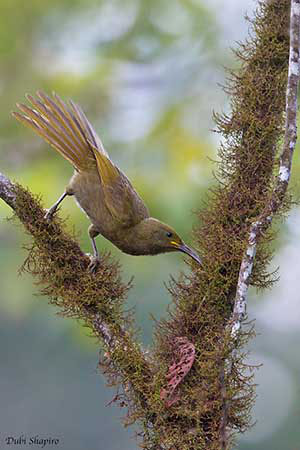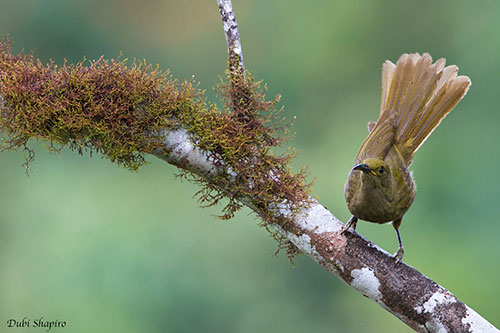
PROTECTION / THREATS / STATUS:
The Giant Honeyeater has restricted range and occurs only on Viti Levu. It can be fairly common in suitable habitat and it is protected by Fijian law. It is present in several protected areas.
The species is affected by degradation and loss of the mature forest habitat. Forests are degraded by logging for domestic use and by agricultural expansion. Only 50% of the islands remain still forested.
The population is not really well estimated with numbers like 130,000 individuals, or 25,000 and 50,000 pairs on Viti Levu.
However, in spite of slow decline, the species is not globally threatened and currently evaluated as Least Concern.
Fr: Méliphage de Viti Levu
Ang: Giant Honeyeater
All: Olivhonigfresser
Esp: Mielero gigante piquipardo
Nd: Bruinsnavelhoningeter
Sd: jättehonungsfågel
Photographer:
Dubi Shapiro
Dubi Shapiro Photo Galleries & Dubi Shapiro's Pictures on IBC
Text by Nicole Bouglouan
Sources:
HANDBOOK OF THE BIRDS OF THE WORLD Vol 13 by Josep del Hoyo-Andrew Elliot-Jordi Sargatal - Lynx Edicions – ISBN: 9788496553453
Birds of Southwest Pacific: A Field Guide to the Birds of the Area between Samoar New Caledonia, and Micronesia By Ernst Mayr, Mayr – Editeur: Tuttle Publishing, 2012 – ISBN: 146290890X, 9781462908905 - 347 pages
The IUCN Red List of Threatened Species
Wikipedia, the free encyclopaedia
Fatbirder - linking birders worldwide... Meliphagidae
CREAGUS – Don Roberson - HONEYEATERS Meliphagidae
Home page
Page Passeriforme Order
Giant Honeyeater
Gymnomyza brunneirostris
Passeriformes Order – Meliphagidae Family
INTRODUCTION:
The Giant Honeyeater is endemic to Fiji and occurs only on Viti Levu.
Until recently, it was treated as conspecific with G. viridis (Yellow-billed Honeyeater), but following a molecular phylogenetic study published in 2014, both showed several differences, including in behaviour. The Giant Honeyeater is now a full species.
It usually frequents mature primary forest, montane forest and mossy montane forest on highest peaks. It feeds mainly on nectar, but it also takes arthropods, berries and fruits.
The Giant Honeyeater is affected by habitat loss, but currently, the species is not globally threatened.
DESCRIPTION OF THE BIRD:
Biometrics:
Length: 25-31 cm
The Giant Honeyeater is a large species with dull olive-green plumage overall. Both flight-feathers and rectrices are tinged yellow. The tail is fairly long.
The long, slender, slightly decurved bill is blackish-brown with yellow moustachial wattle near the gape. The eyes are dark brown. Legs and feet are blackish-brown.
Male and female have similar plumage, but the female is slightly smaller than male.
The juvenile resembles adults, but it has yellowish bill with dark tip.

RANGE:
The Giant Honeyeater is endemic to Fiji and occurs on Viti Levu in W Fiji.
HABITAT:
The Giant Honeyeater frequents a variety of forest habitat types such as mature primary forest, hill and montane forests and mossy rainforest on high peaks.
It is uncommon at forest edges and in forest borders with degraded woodlands, but it may occasionally visit flowering and fruiting trees in cultivated areas close to the mature forest. The species occurs from 80 to 1,300 metres of elevation.
CALLS AND SONGS: SOUNDS BY XENO-CANTO
The Giant Honeyeater gives ringing “kikoo-kikoo-kikoo” or “geeow-geeow”. Several birds may call together, providing a loud cacophony that reverberates through woodlands. They also sing in duets with two birds close to each other, less than 30 centimetres apart.
The birds start calling several hours before dawn, and usually continue until well after dark. However, they are quieter during the middle of the day.
BEHAVIOUR IN THE WILD:
The Giant Honeyeater feeds on nectar, caterpillars, other arthropods, berries and soft fruits.
The honeyeaters have long, protrusible tongue. The tip is brush-like and allows the birds to extract nectar from flowers. However, honeyeaters are not able to perform sustained hovering flight. They collect the nectar by flying quickly from perch to perch in the outer foliage, stretching up and sideways, or even hanging upside-down to reach the flower. The tongue is flicked rapidly and several times into the flower. Then, the nectar is compressed by the upper mandible when the bill is closed.

The Giant Honeyeater forages in outer canopy or subcanopy of tall trees in forest, but it may occasionally reach middle levels or come to the ground.
It takes arthropods by gleaning and is usually very active.
The Giant Honeyeater is shy and more often heard than seen. It is usually observed alone or in twos, often a pair, but they may gather in flocks at abundant food resources.
Sometimes, it becomes aggressive to other species, and especially the Collared Lory around the flowering trees. The lory drives off other birds by biting their wings.
The displays of this species are unknown. The bird becomes aggressive during the breeding season, and some chases in flight probably occur.
We can suggest that the long tail and the yellow moustachial wattle are used during the courtship displays.
The Giant Honeyeater is apparently resident.
This species is mainly arboreal and does not perform long-distance flights.
REPRODUCTION OF THIS SPECIES:
The breeding season is thought to occur between June and October, although other honeyeaters of Fiji may breed throughout the year with peaks activity in February/April, June-July and September/October.
From an observation, only one nest was found. It was cup-shaped and made with rootlets. It was suspended about 18-20 metres from a branch in the outer foliage of a tree of family Malvaceae.
The clutch size of this species is unknown, but only single dependent juveniles have ever been recorded.
